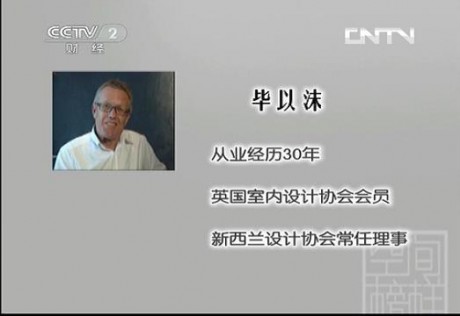 http://jingji.cntv.cn/20130429/104519.shtml
http://jingji.cntv.cn/20130429/104519.shtml
请点击以上链接观看CCTV-2交换空间节目对Roger Billington的专访。
click above interview to see China CCTV’s special design intro on Roger
 http://jingji.cntv.cn/20130429/104519.shtml
http://jingji.cntv.cn/20130429/104519.shtml
请点击以上链接观看CCTV-2交换空间节目对Roger Billington的专访。
click above interview to see China CCTV’s special design intro on Roger
我们要问一个这样的问题,为什么深圳要考虑把设计职业国际化呢?那么,设计国际化到底是什么意思呢?为了回答这些问题,我会先讲讲按我的理解要成为设计中心的必要条件,还有因此能为一个城市或区域的经济和社会发展带来的后果。
我很看重持续教育,并把它看成是我和其它设计师工作的必要部分。这不只是简单地注意最新的设计潮流,而是有方法地、有系统地取得和使用新信息。通过这种做法,我们可以树立应有的态度,其中还可以增加自己那种‘能做新的项目或让现有的项目做得更好’的信心。此外我们也相信创新是新想法的来源,创新文化对于建立新的设计业是至关重要的。我把创新界定为把现有的知识或技术实现到新方法和新用途上。这些是任何行业国际化的根本程序和做法。我今天的演讲就是关于我们怎样在SW设计中心实施这些程序和做法。
现在我已经在中国工作了24个月,服务过两家公司。在这个高速发展的行业中,两家公司都在不断增加毕业生设计师以壮大自身的实力。这对我而言是一个很有趣的机会,可以比较西方教育和中国教育的不同标准和方向。我在英国接受教育,不久前任教于新西兰和澳大利亚的大学,非常了解西方的教育系统,所以可以用同样的知识评估中国的教育系统,更重要的是评估教育成果。
面试了一批中国毕业生,我留意到他们共同的技能和态度。做设计概念的时候,他们用的是标准的绘图方式在纸上画图,呈现作品时都是依赖电脑绘图。他们普遍缺乏专业外的知识,如设计历史、关联专业、材料科技、环保和生态问题、商业技能,最重要的是缺乏挑战常规和质问的态度,总是以某种特定方法去做事情而不思考别的方法。很多欧式教育提倡的是自由、发散性思维和挑战常规,有这样一种说法:“我们的职责就是让学生们去思考,工作是教会他们进行实际的操作。”这是我在西方设计和建筑学院经常听到的。教师对学生讲的东西似乎只适合用于教学,并不太符合现实客户的实际和建筑的现实,这是我对东西方两种教育系统的观察。
我认为两者之间有一种折衷的方法,但很少有学校能达到这种平衡,学者们总是对他们的专业很有激情,所以总以极端的方式教学,或者是参照他们自身受教育的方法传授知识,所以这两种教育系统不断被重复下去。这两种系统的截然不同就是我在西方国家教学和在中国的招聘面试得到的体会,也激发了我的想法并应用在SW的架构上,纠正两方面的缺点,应用两方面的优势,增加我们国内外员工的工作效率和有效性。我与新西兰的三家大学、英国的两家大学都有联系,我们从这些大学聘请一些实习生,他们能贡献于我们的架构,也从我们的架构中得益.
简单地说,我们的做法就是融合这些国际实习生和中国设计师的想法和能力。这样的话每一方都可以体验到与自己不同的设计形式,这是好的国际化设计公司所必要的。中国毕业生通常按惯例做设计,技术很好,但缺乏西方国家毕业生的对历史的学习和创意的探究。并不是说哪个好哪个不好,但把两者结合可以挑战现今社会市场的多元性。当我们把多国设计师融合于我们的团队中时,我们就有了一个创意来源,而且这些创意是可以被实现的。这个世界要求他们要有创意,并要考虑国际化公司所有必须考虑的问题:环境、社会、法律、经济。可能未来最重要的挑战是,我们期望他们增加自信心,能把自己细心想过的、有创意的和合适的设计跟他们的上司或老板理论。这样的话,我们可以确保公司能在规模和复杂性方面壮大,能有信心在国际市场上竞争而不只是口头说说。当这些设计关系壮大起来和成果更清晰的时候,我可以调整这个程序,让等式两边都增加一些内容。我给我公司的中国毕业生布置了一系列设计历史课题,现在我们正准备着55个讲演话题,我还布置了公司SWOT分析,用于评估他们的设计任务书、设计机会和真实客户要求。还有绘画课和电影鉴赏,让他们熟悉国际的场景布置、风格和设计方法。我在外国组织了竞赛,让国际毕业生在他们自己的国家参加竞赛,通过我以前学校的同事让他们接触中国设计工作的速度和规模。
为了辅助这个由我建立的国际毕业生关系架构,我们还有一个国际网络,能联系到英国、新西兰、澳大利亚、泰国、印度和意大利著名的设计师,还有下一个演讲的来自意大利的Guiseppe。他来和我们一道完成一项较大的室内设计工程。我们可以随时让这些充满才能的设计师注入他们的专业意见在我们的项目里,包括建筑、园林、室内和工业设计,和城市规划。当然这些专家也会大大影响着我们的设计毕业生。
除此之外,我还设置了我自己的研究课题目,环保材料和建筑程序会成为SW公司其中一个突出的“文化”。 这不是一时冲动的想法,我把这个课题作为我的业务中最重要的部分。这些问题在西方大学被广泛地讨论,中国毕业生也有必要吸收并应用在他们的设计中,以表现国际化的设计方向和表达出他们对中国和国际环境规范的重视。
这些是有全球意识的客户对设计的最低要求,而以上是为达到这种状态我们该怎样走。我相信无论对SW或我们的中国毕业生,还是对整个中国,这都是一个必要的过程。过去二十年的经济腾飞让这里的设计行业留下了一片空白。中国的很多力量都投入到生产别国需要的产品上,社会和经济中心放在了生产和获取个人财富,然后把财富花费在被西方人视为贵重的产品和服务上。我可以预言消费方向会有改变,越来越多的人会把对西方品牌的喜爱转变为对反映中国文化和历史的产品的喜爱,还有我现在在SW提出要注意的问题的相关产品,包括历史、文化、工艺、环保材料和程序。自信心让我们能以挑战常规的能力对待设计,改变总是按以前的方法做事情的态度,改变老板总是正确的观点。当然在设计世界里,老板不可能总是正确的,事情也不总是按以前的方法做就是对的。。。要学会挑战和质疑常规。
联合国教科文组织在2004年创立了创意城市网络,而深圳已被赋予“设计之都”的头衔。这个创意城市网络是通过会员制的方式增强国际间合作和创意产业的发展。目前此网络中共有七类产业,而设计业是这七类中最重要的。目前SW公司计划了一些活动,如果这些活动在其他设计公司也进行的话,一定能为“设计之都”这个头衔增添价值。例如,我倡导的其中一项内容是聘请一个研究员建立一个材料数据库,把所有的材料按照生态环保度排列次序,这样设计师和建筑师就不需要亲自体验各种物料的环保性、价格和特性。在当今如此快速和复杂的建筑环境当中,设计师面临的最大的困难似乎就是在指定符合国际标准的材料时缺乏相应的信息。我的希望就是通过类似这样的活动,深圳能在国际设计问题中引领中国,不只是影响设计师,还能让材料商意识到环保材料的使用潮流.
创新、挑战性设计越来越适合严峻的市场考验。因此,SW不只是在建立这种声誉,我们也在为我们的未来和中国的设计未来做努力。我以前曾说过“世界在等待中国的设计”,我坚信我们在SW做的事情,正是在中国设计文化迈向成熟的过程中的积极举措。我们在鼓励中国设计师以自己的个性和自信站出来,面对等待着他们的世界。深圳设计的国际化不是要变年轻化或成熟化,也不是要拷贝欧美的设计,更重要的是要让设计程序变得更国际化,从而弘扬中国文化和中国社会,用现代国际的设计方式立足于世界市场。
总而言之,不可否认的是,上海会成为深圳在国际设计领域的模范,而且会比我们想象中发展得快,为了让中国设计师在国际市场竞争中成功,我们要很重视培训和教育系统,完善管理和把质量标准提升到国际竞争者的水平,这样我们才可以在世界最多人口的国家诞生新的设计明星,现在就只有Philippe Starkes, Zaha Hadids, Marc Newson, Ron Arads, Kareem Rashids等等这些外国明星,希望将来在在座的各位中会出现与他们齐名的大师。
谢谢
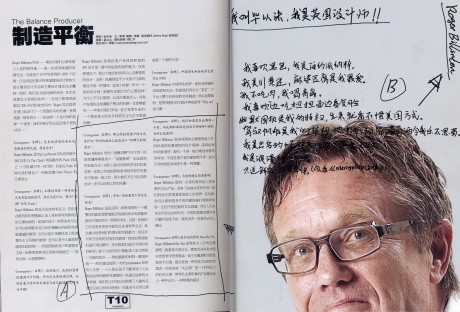 Q: In terms of clients, how do you make a balance between clients’ taste and your design concept? A: I believe the clients come to me and my design studio due to my ability and competence. When they disagree with my concept, being a good designer, I usually tell them the reason why we do this and why we don’t, and the implication of this. After they realize you have all supportive reasons behind the design, they will respect you. After all, you are more professional than they are. A designer, who does whatever he is told to, runs counter to the real art. Q: how do you refuse the clients? You think of yourself a ‘bad tempered’ man. A: Well, I have bad temper indeed, but I know how to respect my client. ‘Persuasion’ is always my first choice. Actually I persuade my students in the studio as well. They are happy to work with me because they don’t only obtain knowledge but have fun. Q: Students? Haven’t you finished teaching career? A: It’s far away. One of main reasons that I came to China is to see whether I can teach Chinese even international students with my knowledge and skills. Currently, there are many young designers and fresh design graduates. I will focus on educating them both theory and practice, which is totally different from Chinese education. I lead them to do the projects and research; therefore each one can learn some knowledge, like latest material, architecture technology, etc., and then they can share these knowledge in a weekly presentation. An individual can never learn all in any industry by themselves, but by sharing, our studio has accumulated lots of valuable knowledge, so you can even say see this is a new university. Q: What’s the difference between Chinese students and international students? A: Chinese students are very good; they are passionate about learning and have talent. However their thinking is a bit ‘rigid’, and they are not used to challenging the tradition and text books. Therefore what I’m going to do is teach them to get used to asking ‘why not’ by practice. Q: We know you have got a home in Chengdu which is a quite different from Shenzhen, so why did you come to Shenzhen? A: Business is the main reason to lead me to Shenzhen, besides; there is a good atmosphere of design here. Shenzhen impresses me by modern, clean and simple and efficient urban plan. Unfortunately, there is little old architecture, which is a shame to the local residents more or less. Q: Is the old architecture so important? A: Yes, it is. It’s the invaluable cultural legacy to human beings. Without it, it is very hard for our offspring to understand and experience their ancestors. In London, you can see many ancient buildings maintained very well, which reflect the cultural details of London and remind people of old times. It’s sad and disappointing to see many old buildings vanish overnight while China is growing. Q: Finally let’s talk about Mao Bar. A: Mao Bar is a theme bar which was run by my wife and me. I like Chinese culture, Mr. Mao and Chinese ancient philosophy. I made the bar on my own to show a concept of combination of dining and fashion. To me, Mr. Mao is a symbolized fashion element. Any product influenced by it gives a special feeling.
Q: In terms of clients, how do you make a balance between clients’ taste and your design concept? A: I believe the clients come to me and my design studio due to my ability and competence. When they disagree with my concept, being a good designer, I usually tell them the reason why we do this and why we don’t, and the implication of this. After they realize you have all supportive reasons behind the design, they will respect you. After all, you are more professional than they are. A designer, who does whatever he is told to, runs counter to the real art. Q: how do you refuse the clients? You think of yourself a ‘bad tempered’ man. A: Well, I have bad temper indeed, but I know how to respect my client. ‘Persuasion’ is always my first choice. Actually I persuade my students in the studio as well. They are happy to work with me because they don’t only obtain knowledge but have fun. Q: Students? Haven’t you finished teaching career? A: It’s far away. One of main reasons that I came to China is to see whether I can teach Chinese even international students with my knowledge and skills. Currently, there are many young designers and fresh design graduates. I will focus on educating them both theory and practice, which is totally different from Chinese education. I lead them to do the projects and research; therefore each one can learn some knowledge, like latest material, architecture technology, etc., and then they can share these knowledge in a weekly presentation. An individual can never learn all in any industry by themselves, but by sharing, our studio has accumulated lots of valuable knowledge, so you can even say see this is a new university. Q: What’s the difference between Chinese students and international students? A: Chinese students are very good; they are passionate about learning and have talent. However their thinking is a bit ‘rigid’, and they are not used to challenging the tradition and text books. Therefore what I’m going to do is teach them to get used to asking ‘why not’ by practice. Q: We know you have got a home in Chengdu which is a quite different from Shenzhen, so why did you come to Shenzhen? A: Business is the main reason to lead me to Shenzhen, besides; there is a good atmosphere of design here. Shenzhen impresses me by modern, clean and simple and efficient urban plan. Unfortunately, there is little old architecture, which is a shame to the local residents more or less. Q: Is the old architecture so important? A: Yes, it is. It’s the invaluable cultural legacy to human beings. Without it, it is very hard for our offspring to understand and experience their ancestors. In London, you can see many ancient buildings maintained very well, which reflect the cultural details of London and remind people of old times. It’s sad and disappointing to see many old buildings vanish overnight while China is growing. Q: Finally let’s talk about Mao Bar. A: Mao Bar is a theme bar which was run by my wife and me. I like Chinese culture, Mr. Mao and Chinese ancient philosophy. I made the bar on my own to show a concept of combination of dining and fashion. To me, Mr. Mao is a symbolized fashion element. Any product influenced by it gives a special feeling.
 There’s an old saying in university education in the west that goes…..if the students are not better than you when they leave ,you have failed to engage them….and so progress, or increase the body of knowledge. These days this certainly depends more on the attitude of the students than the competence of the teacher, but the adage is still true in many ways. This is the philosophy I employ in SW design, and it’s one that addresses the issues raised in the 3 questions asked , stars or teams, backstage heroes, avoidance of brain drain. These are all comments that suggest a certain lack of resolution to the management or running of the business and this is not surprising as the design business in china is still quite young. I have also noted that the standard of training in university lacks a certain future proofing, like, this is the way we do it because this is the way we have always done it and, before you can do this, you must prove you can do that. In the west the approach is significantly different but suffers a certain similarity of result although for different reasons. To address all the above circumstances and questions, I have introduced an internship system, amongst other things, for both Chinese and international graduates and through the integration of these two groups have found a balance that avoids many of the pitfalls of either. As each individual progresses through the company they become confident to make decisions that are based on good research, thorough knowledge of materials, a growing understanding of the history of design and architecture, (something our Chinese graduates know very little of when they arrive here), and an ability to work with the client, not for them, to achieve a design solution that extends expectation and therefore satisfaction. Question one, everybody has had to ‘suffer’ the indignity of having their work represented by their supervisor, this is actually an important part of the business. What client wants to know that their project was undertaken by a young gun with only a year or two’s experience, equally what supervisor has the time or focus to complete all the projects that come into a busy office without substantial support from juniors. This is the way juniors become intermediates and then seniors and then supervisors and so on. I suggest that there is a certain inevitability to the first question through the process of business development, of course there are always those who claim others work as their own and that’s a different question, I suggest you don’t work in those offices if you don’t accept this situation. Question two is one of certain commercial sensitivity as I have taken thirty years to develop the management, administrative and academic structures I am attempting to implement and apply to this Chinese context. However, the question can be discussed through general objectives rather than specific details. I believe the business of design has two levels of approach. One is the’ we do all things for all people’ because we want to be the biggest, or the richest, or whatever, the other is, we want to be the best. To develop a style and approach to design which actually changes people’s lives for the better and acknowledges the real need to understand the place of design in business, not just an addition at the back end of the project. Additionally, and rather obviously, we need to promote a respect for the environmental and sustainable issues often talked about but rarely adopted in such a fast paced society as china today. It is through constant reiteration of these principles and the advantages that they bring that I avoid, I hope, the brain drain effects of simply pushing through the projects as if they don’t have any real purpose or creative, innovative value. I believe most, if not all, of my designers understand that they are experiencing rigorous and professional questioning of the decisions they are making on the projects they work on and that through this the design processes are understood and systematically employed by them. As they progress through seniority, they begin to ask similar questions of the junior designers and so again the process continues. I run design history and materials presentations which are researched by design staff, we conduct analysis of projects and we invite comments from clients and staff on the understanding that all suggestions will be considered, but not necessarily adopted. This gives designers the confidence to be challenged and to challenge, both necessary attitudes for successful design solutions. Self value and high morale is evident with the knowledge that they are in the most progressive design company in Shenzhen, if not china, they inherit a natural self confidence, and as this develops so does my company, so it’s a win/win situation for client/designer/company/the planet. Question three is a natural follow on from the above, there are no world stars in Chinese design. There are no phillipe starckes, ron arads, Philip johnsons, marc newsomes, zaha hadids, ross lovegroves, yet. I think question 3 suitably illustrates my first points, that design in china is still very new. It has not had time or opportunity to address the issues that promote real stardom, if that’s the appropriate word for a socially responsible leader, as top designers are. The policies and practices I am introducing are likely to lead to truly world class thinkers and practitioners of and about design. My strategies at SW are not just about developing a successful business but are geared to the future of Chinese manufacturing and the Chinese economy. When, as is the case, there become cheaper places for the world of manufacturing and designers send their production to viet nam or wherever, china will need innovative, creative and thinking designers to fill the gap and so become the first truly top chinese designers on a world stage where stardom comes as a result of talent and responsibility not just wealth or reputation. My business is geared to engage designers in a process that recognises all these issues and the place of team work to promote quality, people centered designs for our clients. Within this office, the issue of stardom or teamwork as options does not exist, we have both……… Roger B.
There’s an old saying in university education in the west that goes…..if the students are not better than you when they leave ,you have failed to engage them….and so progress, or increase the body of knowledge. These days this certainly depends more on the attitude of the students than the competence of the teacher, but the adage is still true in many ways. This is the philosophy I employ in SW design, and it’s one that addresses the issues raised in the 3 questions asked , stars or teams, backstage heroes, avoidance of brain drain. These are all comments that suggest a certain lack of resolution to the management or running of the business and this is not surprising as the design business in china is still quite young. I have also noted that the standard of training in university lacks a certain future proofing, like, this is the way we do it because this is the way we have always done it and, before you can do this, you must prove you can do that. In the west the approach is significantly different but suffers a certain similarity of result although for different reasons. To address all the above circumstances and questions, I have introduced an internship system, amongst other things, for both Chinese and international graduates and through the integration of these two groups have found a balance that avoids many of the pitfalls of either. As each individual progresses through the company they become confident to make decisions that are based on good research, thorough knowledge of materials, a growing understanding of the history of design and architecture, (something our Chinese graduates know very little of when they arrive here), and an ability to work with the client, not for them, to achieve a design solution that extends expectation and therefore satisfaction. Question one, everybody has had to ‘suffer’ the indignity of having their work represented by their supervisor, this is actually an important part of the business. What client wants to know that their project was undertaken by a young gun with only a year or two’s experience, equally what supervisor has the time or focus to complete all the projects that come into a busy office without substantial support from juniors. This is the way juniors become intermediates and then seniors and then supervisors and so on. I suggest that there is a certain inevitability to the first question through the process of business development, of course there are always those who claim others work as their own and that’s a different question, I suggest you don’t work in those offices if you don’t accept this situation. Question two is one of certain commercial sensitivity as I have taken thirty years to develop the management, administrative and academic structures I am attempting to implement and apply to this Chinese context. However, the question can be discussed through general objectives rather than specific details. I believe the business of design has two levels of approach. One is the’ we do all things for all people’ because we want to be the biggest, or the richest, or whatever, the other is, we want to be the best. To develop a style and approach to design which actually changes people’s lives for the better and acknowledges the real need to understand the place of design in business, not just an addition at the back end of the project. Additionally, and rather obviously, we need to promote a respect for the environmental and sustainable issues often talked about but rarely adopted in such a fast paced society as china today. It is through constant reiteration of these principles and the advantages that they bring that I avoid, I hope, the brain drain effects of simply pushing through the projects as if they don’t have any real purpose or creative, innovative value. I believe most, if not all, of my designers understand that they are experiencing rigorous and professional questioning of the decisions they are making on the projects they work on and that through this the design processes are understood and systematically employed by them. As they progress through seniority, they begin to ask similar questions of the junior designers and so again the process continues. I run design history and materials presentations which are researched by design staff, we conduct analysis of projects and we invite comments from clients and staff on the understanding that all suggestions will be considered, but not necessarily adopted. This gives designers the confidence to be challenged and to challenge, both necessary attitudes for successful design solutions. Self value and high morale is evident with the knowledge that they are in the most progressive design company in Shenzhen, if not china, they inherit a natural self confidence, and as this develops so does my company, so it’s a win/win situation for client/designer/company/the planet. Question three is a natural follow on from the above, there are no world stars in Chinese design. There are no phillipe starckes, ron arads, Philip johnsons, marc newsomes, zaha hadids, ross lovegroves, yet. I think question 3 suitably illustrates my first points, that design in china is still very new. It has not had time or opportunity to address the issues that promote real stardom, if that’s the appropriate word for a socially responsible leader, as top designers are. The policies and practices I am introducing are likely to lead to truly world class thinkers and practitioners of and about design. My strategies at SW are not just about developing a successful business but are geared to the future of Chinese manufacturing and the Chinese economy. When, as is the case, there become cheaper places for the world of manufacturing and designers send their production to viet nam or wherever, china will need innovative, creative and thinking designers to fill the gap and so become the first truly top chinese designers on a world stage where stardom comes as a result of talent and responsibility not just wealth or reputation. My business is geared to engage designers in a process that recognises all these issues and the place of team work to promote quality, people centered designs for our clients. Within this office, the issue of stardom or teamwork as options does not exist, we have both……… Roger B.
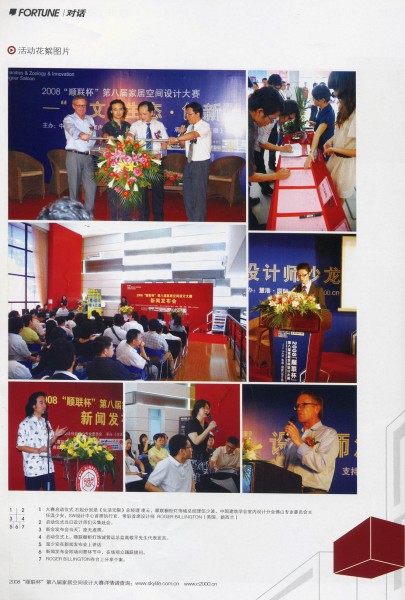
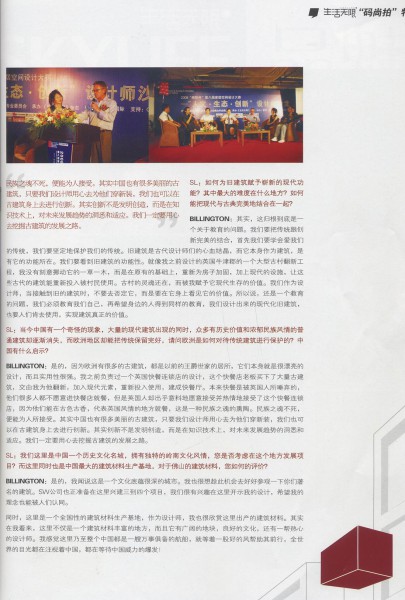
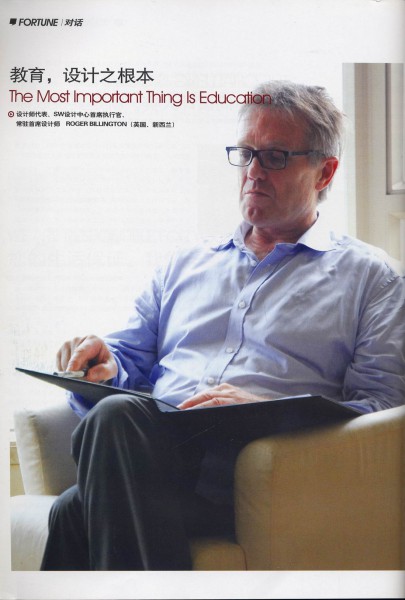 Q: How to vest modern function with the old style architecture? What’s the biggest difficulty? How to integrate both modern and classic? A: Essentially this is a matter of education. To achieve this, we need to appreciate our tradition and protect it. Old architecture was the fruit of our ancient architects, and it self had its own function which we need to learn. For instance, I used to renovate an ancient village in Oxford shire in UK. I didn’t mean to touch anything, but tried to reinforce the house and add in modern facilities before the old building could be re-used by the villagers. The village kept its soul but was endowed with modern values by me. Being designers, we need to appreciate the value of old buildings and architecture, instead of negating it. This is all about education. We have to educate ourselves before teaching other people. Only when people would use it with pleasure, will the value of architecture be realized. Q: Currently there is a phenomenon in China that many historic architectures and vernacular buildings vanish gradually while heaps of modern buildings arise. Conversely, in Europe, traditional buildings are protected very well. How do they do this? What can China learn from this? A: it’s true. Most of old European buildings used to be the royal’s habitats which were great designs with strong functions. I was in charge of a design for a fast food chain store in UK. The owner purchased many old buildings and asked me to renovate them with modern elements. Fast food is unpopular with English people and many of them would not like to choose a fast food store for a meal. Unexpectedly, the English people accept fast food because they enjoy dining in a place with original english culture. This is ethos edification. Actually, there are many amazing ancient buildings in China. As long as our designers renovate them with heart, we can see the creativity on those buildings. Unlike invention, creativity is defined as the discernment of and adaptation to future development with technical knowledge. We must find out the future of ancient architecture. Q: Foshan is a historic city in China which is rich in vernacular culture. Do you think about some projects here? Foshan is the biggest production base of building material in China, and how do you value the material here? A: I have heard of the city with its rich culture and I would like to take the opportunity to visit some architectures. SW is preparing for 3 to 4 projects here so we are keen to show my design and I hope my design concepts can be appreciated. Meanwhile, as a designer, I really appreciate the material here. In my opinion, this place is not only rich in building material, but rich in culture and designers. I think China is like a ship which is ready for the journey. The world is watching China and waits for it to march.
Q: How to vest modern function with the old style architecture? What’s the biggest difficulty? How to integrate both modern and classic? A: Essentially this is a matter of education. To achieve this, we need to appreciate our tradition and protect it. Old architecture was the fruit of our ancient architects, and it self had its own function which we need to learn. For instance, I used to renovate an ancient village in Oxford shire in UK. I didn’t mean to touch anything, but tried to reinforce the house and add in modern facilities before the old building could be re-used by the villagers. The village kept its soul but was endowed with modern values by me. Being designers, we need to appreciate the value of old buildings and architecture, instead of negating it. This is all about education. We have to educate ourselves before teaching other people. Only when people would use it with pleasure, will the value of architecture be realized. Q: Currently there is a phenomenon in China that many historic architectures and vernacular buildings vanish gradually while heaps of modern buildings arise. Conversely, in Europe, traditional buildings are protected very well. How do they do this? What can China learn from this? A: it’s true. Most of old European buildings used to be the royal’s habitats which were great designs with strong functions. I was in charge of a design for a fast food chain store in UK. The owner purchased many old buildings and asked me to renovate them with modern elements. Fast food is unpopular with English people and many of them would not like to choose a fast food store for a meal. Unexpectedly, the English people accept fast food because they enjoy dining in a place with original english culture. This is ethos edification. Actually, there are many amazing ancient buildings in China. As long as our designers renovate them with heart, we can see the creativity on those buildings. Unlike invention, creativity is defined as the discernment of and adaptation to future development with technical knowledge. We must find out the future of ancient architecture. Q: Foshan is a historic city in China which is rich in vernacular culture. Do you think about some projects here? Foshan is the biggest production base of building material in China, and how do you value the material here? A: I have heard of the city with its rich culture and I would like to take the opportunity to visit some architectures. SW is preparing for 3 to 4 projects here so we are keen to show my design and I hope my design concepts can be appreciated. Meanwhile, as a designer, I really appreciate the material here. In my opinion, this place is not only rich in building material, but rich in culture and designers. I think China is like a ship which is ready for the journey. The world is watching China and waits for it to march.
 Q: As a designer, pick up a word to describe yourself.
Q: As a designer, pick up a word to describe yourself.

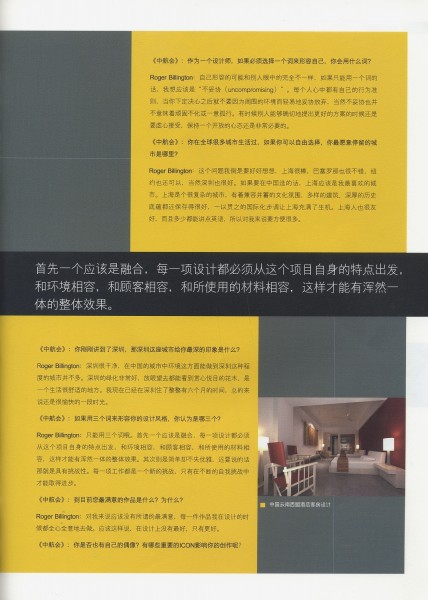



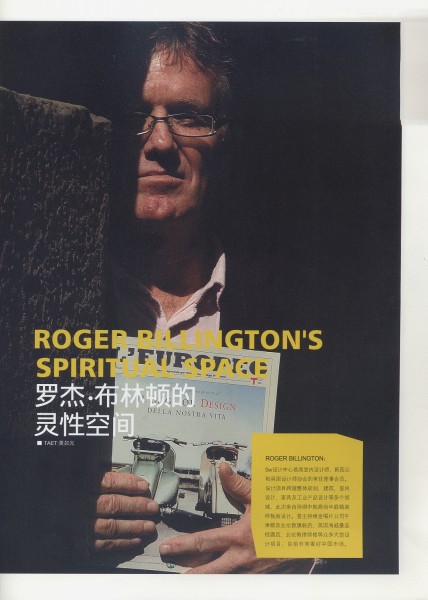
 A: People see you differently from you do yourself. If only one word is allowed to describe myself, I would say ‘uncompromising’. Everyone has its own principle. Once it’s determined, don’t compromise it to surroundings so easily. Of course, uncompromising doesn’t mean go your own way. Sometimes when other people propose a better solution, you need to accept it. It’s important to leave your heart open. Q: You have been to many places of the world. Which city would you most likely stay? A: I have to think about it. Shanghai is good, Barcelona is not bad, New York is ok and of course Shenzhen is good too. If I have to choose within China, Shanghai is my favorite city. Shanghai is a complicated city with multi-cultural atmosphere, diversified architecture, well preserved historic culture. Internationalization gives it life. Local people are friendly and can speak English more or less, which is convenient to me. Q: What’s your impression of Shenzhen? A: Shenzhen is very clean. It’s rare to see such a clean city in China. Shenzhen has done a good job in landscaping, so you can see trees and blossoms everywhere. It’s a comfortable place to live. I have been living in here for 6 months and I had a good time. Q: Pick up 3 words to describe your design style A: First of all, integration. Each design starts with the project’s feature to make it integrate with its environment, client, and material, then each part becomes integral part of the whole. Secondly, simple but sophisticated. Finally is challenging. Each job is a new challenge from which we learn and advance. Q: What’s your most satisfied work so far? A: To me, there is no such a most satisfied work because I dedicate to each single project with my heart. I should say there has always been no best design, but a better design. Q: Do you have any idol? Does any idol influence your creation? A: The older you get, the less idol you will have, because you realize every one has its limitation. Jimi Hendirix is a great guitar player who I used to admire as young and I still do. In design industry, Norman Foster is irreplaceable to me and so is Renzo Piano, although there are few idols to me in design area. Norman Foster dedicated his life to practicing an attitude to architecture. His work has been sustainable, practical and human related. Some massive buildings are environmentally and human friendly. For instance, HK airport, before start, you have to understand and respect people. Essentially design is to facilitate people not just to look good. Q: Which do you prefer, spatial or product design? If you didn’t choose design, what else career would you take? A: There is no difference to me because there is something in common between interior design and product design, common approach, attitude and philosophy. To be a designer, you have to have your own design philosophy and put them into design practice. Therefore it doesn’t matter to differentiate areas in design. I haven’t thought about other careers yet because I have been interested in design since young. My mother was a fashion designer, so since I had memory, I have been living in a visual world and all I have been doing is related to vision. If I didn’t do design, I would become an artist. Q: In Shenzhen, in a job of your interior designs—zhonghang, you created styles of ‘escape from urban, easy living and New York modern’. How did you come up with these inspirations, especially ‘escape’? A: Show room design is to maximize the needs of potential customers, so before we started we did a lot of research, and finally we focused on 3 typical target groups: a young couple, a couple with adult children, and a family with 3 generations, each having their own character. Interior design is far more than putting followers on the table, but requires designers have clear conception before start. Every people living in the contemporary metropolises are facing the pressure of survival, so home should play a role of port where people can rest. This is where ‘escape from the urban’ came from. Temporary escape is not equal to seclusion because the contemporary youth need elegance and fashion as well. This is the core of this theme.
A: People see you differently from you do yourself. If only one word is allowed to describe myself, I would say ‘uncompromising’. Everyone has its own principle. Once it’s determined, don’t compromise it to surroundings so easily. Of course, uncompromising doesn’t mean go your own way. Sometimes when other people propose a better solution, you need to accept it. It’s important to leave your heart open. Q: You have been to many places of the world. Which city would you most likely stay? A: I have to think about it. Shanghai is good, Barcelona is not bad, New York is ok and of course Shenzhen is good too. If I have to choose within China, Shanghai is my favorite city. Shanghai is a complicated city with multi-cultural atmosphere, diversified architecture, well preserved historic culture. Internationalization gives it life. Local people are friendly and can speak English more or less, which is convenient to me. Q: What’s your impression of Shenzhen? A: Shenzhen is very clean. It’s rare to see such a clean city in China. Shenzhen has done a good job in landscaping, so you can see trees and blossoms everywhere. It’s a comfortable place to live. I have been living in here for 6 months and I had a good time. Q: Pick up 3 words to describe your design style A: First of all, integration. Each design starts with the project’s feature to make it integrate with its environment, client, and material, then each part becomes integral part of the whole. Secondly, simple but sophisticated. Finally is challenging. Each job is a new challenge from which we learn and advance. Q: What’s your most satisfied work so far? A: To me, there is no such a most satisfied work because I dedicate to each single project with my heart. I should say there has always been no best design, but a better design. Q: Do you have any idol? Does any idol influence your creation? A: The older you get, the less idol you will have, because you realize every one has its limitation. Jimi Hendirix is a great guitar player who I used to admire as young and I still do. In design industry, Norman Foster is irreplaceable to me and so is Renzo Piano, although there are few idols to me in design area. Norman Foster dedicated his life to practicing an attitude to architecture. His work has been sustainable, practical and human related. Some massive buildings are environmentally and human friendly. For instance, HK airport, before start, you have to understand and respect people. Essentially design is to facilitate people not just to look good. Q: Which do you prefer, spatial or product design? If you didn’t choose design, what else career would you take? A: There is no difference to me because there is something in common between interior design and product design, common approach, attitude and philosophy. To be a designer, you have to have your own design philosophy and put them into design practice. Therefore it doesn’t matter to differentiate areas in design. I haven’t thought about other careers yet because I have been interested in design since young. My mother was a fashion designer, so since I had memory, I have been living in a visual world and all I have been doing is related to vision. If I didn’t do design, I would become an artist. Q: In Shenzhen, in a job of your interior designs—zhonghang, you created styles of ‘escape from urban, easy living and New York modern’. How did you come up with these inspirations, especially ‘escape’? A: Show room design is to maximize the needs of potential customers, so before we started we did a lot of research, and finally we focused on 3 typical target groups: a young couple, a couple with adult children, and a family with 3 generations, each having their own character. Interior design is far more than putting followers on the table, but requires designers have clear conception before start. Every people living in the contemporary metropolises are facing the pressure of survival, so home should play a role of port where people can rest. This is where ‘escape from the urban’ came from. Temporary escape is not equal to seclusion because the contemporary youth need elegance and fashion as well. This is the core of this theme.